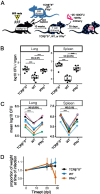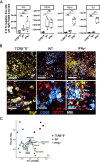This is a preprint.
Re-appraising the role of T-cell derived interferon gamma in restriction of Mycobacterium tuberculosis in the murine lung: T-cell derived IFNγ is required to restrict pulmonary Mtb
- PMID: 38617280
- PMCID: PMC11014638
- DOI: 10.1101/2024.04.04.588086
Re-appraising the role of T-cell derived interferon gamma in restriction of Mycobacterium tuberculosis in the murine lung: T-cell derived IFNγ is required to restrict pulmonary Mtb
Update in
-
Reappraising the Role of T Cell-Derived IFN-γ in Restriction of Mycobacterium tuberculosis in the Murine Lung.J Immunol. 2024 Aug 1;213(3):339-346. doi: 10.4049/jimmunol.2400145. J Immunol. 2024. PMID: 38912839 Free PMC article.
Abstract
T cells producing interferon gamma (IFNγ) have long been considered a stalwart for immune protection against Mycobacterium tuberculosis (Mtb), but their relative importance to pulmonary immunity has been challenged by murine studies which achieved protection by adoptively transferred Mtb-specific IFNγ-/- T cells. Using IFNγ-/- T cell chimeric mice and adoptive transfer of IFNγ-/- T cells into TCRβ-/-δ-/- mice, we demonstrate that control of lung Mtb burden is in fact dependent on T cell-derived IFNγ, and furthermore, mice selectively deficient in T cell-derived IFNγ develop exacerbated disease compared to T cell-deficient controls despite equivalent lung bacterial burdens. Deficiency in T cell-derived IFNγ skews infected and bystander monocyte-derived macrophages (MDMs) to an alternative M2 phenotype, and promotes neutrophil and eosinophil influx. Our studies support an important role for T cell-derived IFNγ in pulmonary immunity against TB.
Figures




References
-
- Caruso A. M., Serbina N., Klein E., Triebold K., Bloom B. R., and Flynn J. L.. 1999. Mice deficient in CD4 T cells have only transiently diminished levels of IFN-gamma, yet succumb to tuberculosis. J Immunol 162: 5407–5416. - PubMed
-
- Casanova J.-L., and Abel L.. 2002. Genetic dissection of immunity to mycobacteria: the human model. Annu Rev Immunol 20: 581–620. - PubMed
-
- Esmail H., Riou C., du Bruyn E., Lai R. P.-J., Harley Y. X. R., Meintjes G., Wilkinson K. A., and Wilkinson R. J.. 2018. The Immune Response to Mycobacterium tuberculosis in HIV-1-Coinfected Persons. Annu Rev Immunol 36: 603–638. - PubMed
-
- Pearl J. E., Saunders B., Ehlers S., Orme I. M., and Cooper A. M.. 2001. Inflammation and Lymphocyte Activation during Mycobacterial Infection in the Interferon-γ-Deficient Mouse. Cellular Immunology 211: 43–50. - PubMed
Publication types
Grants and funding
LinkOut - more resources
Full Text Sources
